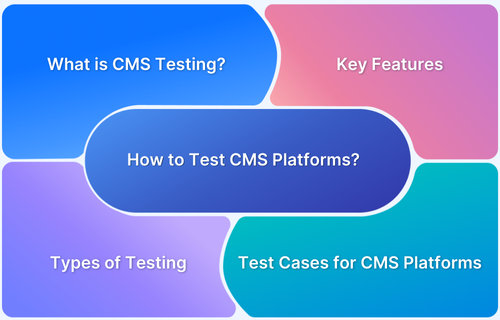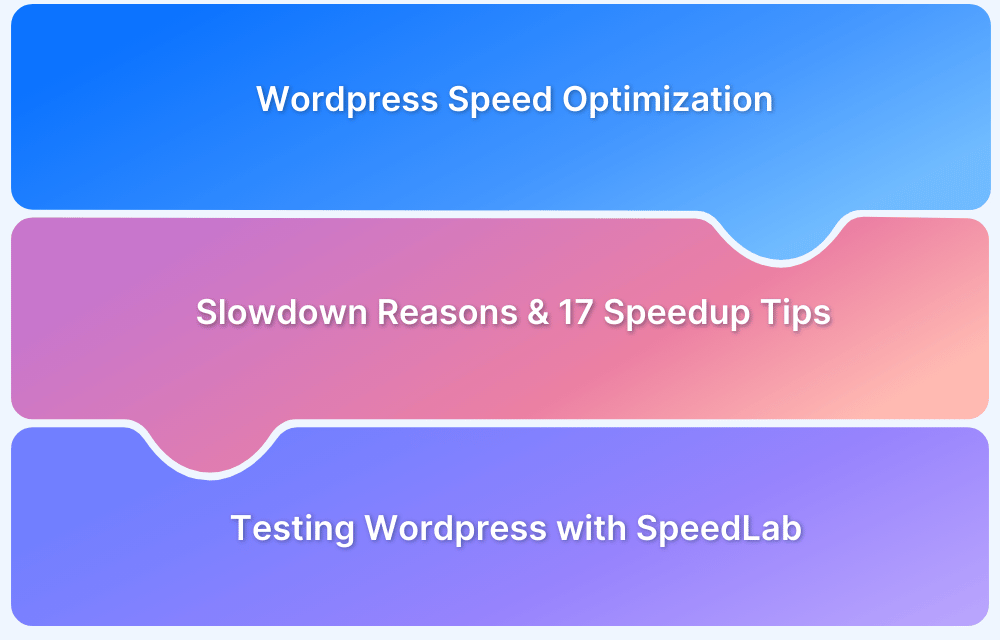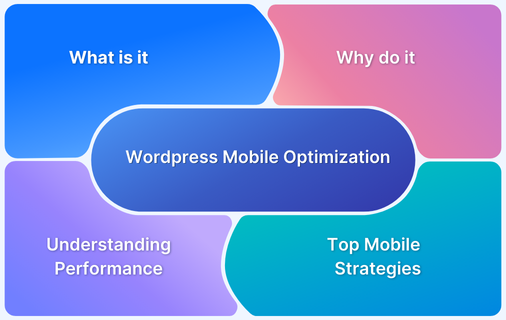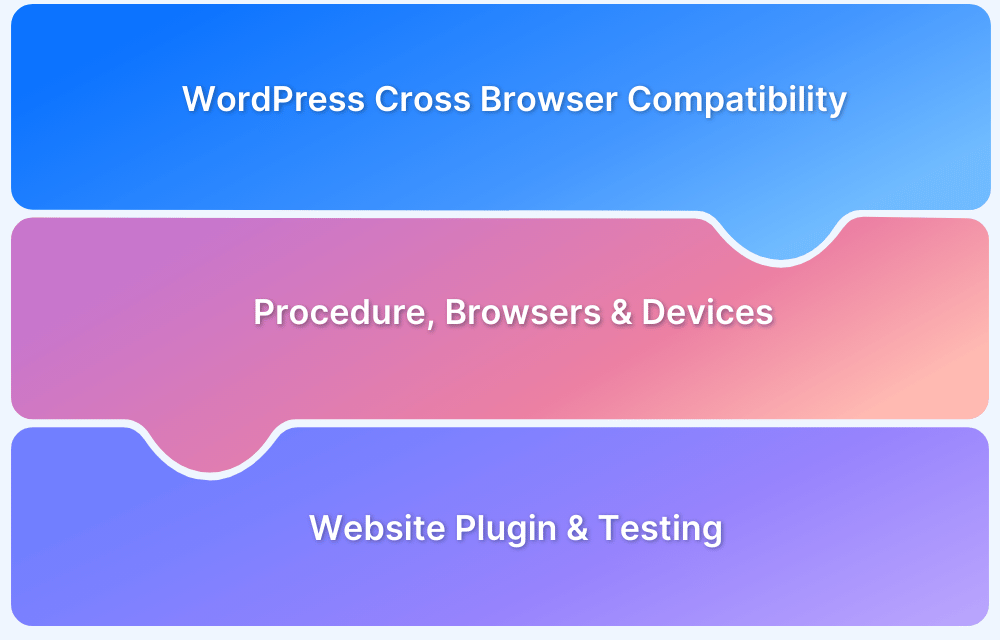Content Management Systems (CMS) enable users to create, manage, and publish digital content efficiently on the World Wide Web. A well-functioning CMS is critical for many from small blogs to large e-commerce platforms.
Whether it is a popular CMS or a custom one, ensuring that your chosen platform works flawlessly isn’t just about aesthetics; CMS testing guarantees a smooth user experience, maintains data integrity, and safeguards your online presence.
Thorough testing is paramount, and this article will guide you through various testing approaches with test cases and practical examples.
What is CMS Testing?
The goal of CMS testing is to identify bugs, errors, or inefficiencies before they impact the user experience or the website’s overall performance.
CMS testing is the process of evaluating a content management system or the generated content to ensure that all functionalities perform as intended and that it meets the specific requirements of its users.
Many popular CMS, such as WordPress, Drupal, and Joomla, are available, and many people build custom CMS for various purposes. Testing is necessary before deployment to ensure a seamless content cycle.
With an increasing number of e-commerce workflows being templated on CMS platforms like Shopify, the adoption rates are increasing, and testing for validating business processes is gaining traction.
Key Features of CMS Platforms
Before diving into testing, it’s essential to understand these functionalities, which are common and must be rigorously checked during CMS testing:
- Content Creation and Management: Features for creating, editing, and organizing pages, posts, and other content.
- User Management: Capabilities for creating, managing, and assigning user roles and permissions.
- Media Management: Tools for uploading, organizing, and displaying images, videos, and other media assets.
- Plugin/Extension Management: Options for installing and configuring additional functionality through plugins or extensions.
- Theme Customization: Tools for customizing the site’s visual appearance through themes.
- SEO Management: Features for optimizing content for search engines through meta descriptions, keywords, and other techniques.
- Form Management: Create and manage forms for data capture.
- Transaction Management: Managing sales, subscriptions, offers, and more with dynamic transactions.
Why is CMS Testing Important?
CMS testing is essential for several reasons, and its importance can’t be overstated.
Here are some key benefits:
- Ensures functionality works as intended: Testing helps verify all the core features of a page operate as expected.
- Provides a user-friendly experience: Thorough testing ensures a seamless experience that is both intuitive and user-friendly.
- Minimizes errors and downtime: By catching issues during testing, you can prevent problems that lead to downtime and lost traffic.
- Safeguards against security breaches: Regular security testing helps identify vulnerabilities and prevents unauthorized access to your site.
- Enhances overall performance and speed: Performance tests and optimization ensure that your CMS loads quickly and handles traffic efficiently.
- Boosts SEO effectiveness: By verifying that SEO functionalities are properly implemented, you ensure better visibility on search engine results.
Types of Testing for CMS Platforms
Testing a CMS requires a multifaceted approach. Different types of testing are necessary to ensure that every aspect of the platform functions correctly and provides a positive user experience.
Here’s a breakdown of the key testing types:
Functional Testing
Functional testing focuses on verifying that each feature of the CMS works according to its design specifications and delivers the right functionality.
What to Test:
- Content Management: Creating, editing, deleting, and publishing pages and posts.
- User Management: User creation, role assignment, login, and authorization processes.
- Media Management: Uploading, organizing, and displaying images and videos.
- Plugin/Extension Management: Installing, configuring, and testing functionality of plugins and extensions.
Usability Testing
Usability testing examines how easy users can interact with and navigate the CMS. It focuses on the user experience (UX) and ensures that the CMS is intuitive and efficient.
What to Test:
- Ease of Navigation: How easily users can find what they need.
- Clarity of Content: Whether instructions, labels, and other elements are clear and understandable.
- User Interface (UI) Design: The visual layout and organization of the CMS interface.
- Multilingual Support: Ensure content can be created and displayed in multiple languages.
Compatibility Testing
Compatibility testing ensures that the CMS works consistently across various environments. This is critical because users may access the CMS through different browsers, operating systems, and devices.
What to Test:
- Browser Compatibility: Chrome, Firefox, Safari, Edge, and other browsers (including older versions).
- Operating System Compatibility: Windows, macOS, Linux, iOS, Android, etc.
- Screen Resolution and Orientation: Testing with various resolutions and landscape/portrait modes.
- Responsive Design: Ensuring that the layout adapts correctly to different screen sizes.
Must Read: How to approach Cross Platform Testing
Performance Testing
Performance testing focuses on evaluating the CMS’s speed, scalability, and stability. The goal is to identify bottlenecks and ensure that the CMS can handle expected workloads and traffic.
What to Test:
- Page Load Times: How quickly pages load under normal and peak traffic conditions.
- Response Time: The time the CMS takes to respond to user actions.
- Scalability: The ability of the CMS to handle increasing traffic and data loads.
- Resource Utilization: CPU, memory, and other resource consumption.
Also Read: How to check Website Loading Time
Security Testing
Security testing aims to identify any potential vulnerabilities in the CMS that malicious actors could exploit.
What to Test:
- Authentication and Authorization: Verify secure login, password protection, and permission management.
- Data Protection: Protecting user data from unauthorized access and modification.
- Vulnerabilities: Cross-Site Scripting (XSS), SQL injection, and other common security threats.
- Session Management: Ensure secure session handling to prevent unauthorized access.
- Data Privacy Compliance: GDPR, CCPA, and other data protection standards.
Test Cases for CMS Platforms
A well-structured test case includes a unique identifier, a description, preconditions, steps, and expected outcomes.
Here’s a list of some Test Cases for CMS Platforms
- Verify Login and Authorization
- Verify Content Management
- Verify Media Handling and Display
- Verify User Management and Role Creation
- Verify SEO Management
- Verify Form Management
- Verify plugin installation, activation, deactivation, and functionality
- Verify theme installation, activation, and customization options
- Verify search functionality and accuracy
- Verify multilingual support and switching between languages
- Verify backup and restore functionality
- Verify sitemap generation and validity
- Verify email notification functionality
Below is a detailed explanation of each test case with steps:
Test Case: Verify Login and Authorization
Verify that users can successfully log into the CMS with valid credentials and are appropriately authorized based on their role.
Steps:
- Navigate to the login page.
- Enter valid username and password.
- Attempt login with invalid credentials (e.g., incorrect password or username).
- Attempt login with an inactive account.
- Verify multi-factor authentication (if enabled).
- Verify login attempts with incorrect CAPTCHA (if applicable).
- Verify access to restricted pages for unauthorized users.
Expected Result:
- Users with valid credentials can log in.
- Unauthorized users are restricted from accessing protected pages.
- Proper error messages are displayed for invalid or failed logins.
Test Case: Verify Content Management
Verify that users can create, edit, and delete content (e.g., pages, posts) within the CMS.
Steps:
- Create a new article/page with text, images, and formatting.
- Edit the content and save changes.
- Preview the page before publishing.
- Publish the content and verify it displays correctly on the front end.
- Delete the content and verify it is no longer accessible.
Expected Result:
- Content is successfully created, edited, published, and deleted.
- Changes reflect correctly in previews and on the live site.
Test Case: Verify Media Handling and Display
Verify users can upload, manage, and display media (images, videos) within the CMS.
Steps:
- Upload images, videos, and documents of various formats.
- Verify file size and format restrictions.
- Edit media metadata (e.g., alt text, titles).
- Embed media in content and verify it displays correctly on different devices.
- Test media deletion and confirm its removal from the site.
Expected Result:
- Media uploads, displays, and integrates with content seamlessly.
- Invalid file types or oversized files show appropriate error messages.
Test Case: Verify User Management and Role Creation
Verify that users can be created and assigned roles, and that permissions are correctly applied based on the roles.
Steps:
- Create new roles with specific permissions.
- Assign roles to users and verify access to corresponding features.
- Attempt restricted actions with users having limited permissions.
- Modify or delete roles and observe system behavior.
- Test user deactivation and reactivation.
Expected Result:
- Users can perform actions based on their roles.
- Unauthorized actions are blocked with clear error messages.
Test Case: Verify SEO Management
Verify that SEO settings can be configured and are reflected in the website’s metadata.
Steps:
- Edit page titles, meta descriptions, and keywords.
- Create and update an XML sitemap.
- Configure canonical URLs and verify they reflect in the source code.
- Test URL customization for readability and keywords.
- Verify robots.txt configuration for search engine indexing.
Expected Result:
- SEO settings update successfully and reflect in the source code.
- Sitemaps and robots.txt are accessible and correct.
Test Case: Verify Form Management
Verify that forms can be created and that user input is captured and handled correctly.
Steps:
- Create a new form with fields (e.g., text, dropdowns, radio buttons).
- Configure form validations (e.g., required fields, email format).
- Test form submissions with valid and invalid inputs.
- Verify email notifications or backend data storage for submissions.
- Attempt to submit duplicate entries (if restricted).
Expected Result:
- Forms are created and displayed correctly.
- Validations work as intended.
- Submissions are processed and stored or emailed successfully.
Additional Test Cases
Below are some additional test cases for CMS platforms:
- Verify plugin installation, activation, deactivation, and functionality.
- Verify theme installation, activation, and customization options.
- Verify search functionality and accuracy.
- Verify multilingual support and switching between languages.
- Verify backup and restore functionality.
- Verify sitemap generation and validity.
- Verify email notification functionality (e.g., for new users or form submissions).
Test CMS Platforms on Real Devices
When testing CMS platforms, it’s crucial to ensure they work seamlessly across multiple browsers and devices. Testing a CMS platform across browsers on real devices ensures compatibility, responsiveness, and consistent user experience.
Here’s a structured approach to check key areas:
- UI Consistency: Check alignment, layout, colors, fonts, and design across devices and browsers to avoid visual discrepancies like overlapping elements or missing assets.
- Responsiveness: Test how the CMS adapts to various screen sizes, ensuring menus, forms, and content remain accessible and functional.
- Functionality: Validate core CMS features like login, content creation, publishing, and media management, along with JavaScript-based features like drag-and-drop or modal popups.
- Performance: Evaluate load times and responsiveness under low bandwidth or high latency conditions, and ensure smooth operation on lower-spec devices.
- Browser-Specific Features: Identify quirks in rendering or unsupported CSS/JavaScript across browsers and check compatibility with extensions or add-ons.
- Device-Specific Features: Test touch gestures, swipe actions, and on-screen keyboards on mobile devices while ensuring compatibility with features like Retina displays or high DPI settings.
Selecting the right testing tools for this job can be a tricky task.
Why you should Test your CMS Platforms on BrowserStack Live
BrowserStack Live is a powerful tool to test your CMS Platform on a real device cloud.
Here are some of its core features that you can leverage to test CMS effectively:
- Access to Real Devices and Browsers: Test on 3,500+ real devices, popular OS like Windows, macOS, Android, iOS, and browsers like Chrome, Firefox, Safari, and Edge.
- Instant Cloud Access: Skip physical setups; access devices instantly via the cloud for quick and hassle-free testing.
- Responsive Design Testing: Verify CMS themes on different screen sizes and orientations, ensuring adaptability across devices.
- Debugging Tools: Use built-in tools like DevTools to inspect, debug, and view logs or JavaScript errors in real-time.
- Cross-Browser Automation: Automate repetitive CMS tests with Selenium and run parallel tests on multiple browser-device combinations.
- Geo-Location Testing: Simulate regional performance by testing language, currency, and localized features across the globe.
- Seamless Integration: Streamline workflows with CI/CD tools like Jenkins, CircleCI, and GitHub Actions.
- Live Testing for Manual QA: Manually test CMS functionality, usability, and visuals on real devices in real-time.
Common Challenges in CMS Testing
Testing CMS platforms is not always straightforward, and several common challenges can complicate the process.
Understanding these hurdles can help you prepare and mitigate potential issues like:
- Complexity of CMS Systems: Modern CMS platforms are feature-rich and complex, with many interconnected components. This intricacy makes it challenging to test all the possible functions’ combinations and permutations.
- Plugin and Theme Conflicts: CMS platforms often rely on third-party plugins and themes. These external components can introduce compatibility issues, conflicts, or security vulnerabilities, making it difficult to maintain a stable and consistent testing environment.
- Compatibility Issues: Ensuring cross-browser and cross-device compatibility is a constant challenge. Variations in how different browsers and devices render pages can result in inconsistent user experiences, requiring extensive testing and debugging.
- Handling Dynamic Content: CMS platforms often generate content dynamically. Testing this dynamic content requires verifying that content is properly rendered and that the relationships between different data elements are correctly managed, which can be complex.
- Limited Test Environments: Creating realistic test environments can be expensive and time-consuming. Testing all possible configurations and scenarios may not be feasible, requiring careful prioritization.
- User Experience Challenges: Testing user experience aspects requires understanding diverse user needs, workflows, and usage patterns. Gaining insights from real users can be challenging and requires dedicated resources and methodologies.
Also Read: Use Case vs Test Case: Core Differences
Best Practices for Testing CMS Platforms
To overcome the challenges of CMS testing and ensure thorough coverage, follow these best practices:
- Plan Test Requirements: Define CMS features, functionalities, and goals with a clear test plan outlining scope, objectives, and approach.
- Combine Manual and Automated Testing: Use manual testing for UX and exploratory testing, and automation for regression and repetitive tasks.
- Select the Right Tools: Choose tools like automation, performance, and security scanners, along with platforms like BrowserStack Live.
- Create Detailed Test Reports: Document test cases, results, defects, and recommendations for effective communication and decision-making.
- Perform Regular Regression Tests: Test after updates to ensure functionality remains intact; automate for efficiency.
- Prioritize Test Cases: Focus on critical features based on business impact, risk, and user frequency.
- Test on Real Devices: Use real devices instead of simulators to catch compatibility and usability issues.
- Leverage CI/CD Pipelines: Integrate automated testing into CI/CD for continuous quality feedback and early issue detection.
- Involve Users: Conduct usability and acceptance testing with real users to ensure the CMS meets their needs.
- Early Security Testing: Include security checks throughout development to build secure functionality from the start.
Conclusion
Testing CMS platforms is a complex but vital process that ensures functionality, usability, performance, and security. You can create robust and reliable CMS systems by understanding the challenges, applying best practices, and using appropriate tools like BrowserStack Live.
Thorough and continuous testing is essential for delivering a positive user experience, protecting against security vulnerabilities, and maintaining the long-term success of any web-based application built on a CMS.
Remember that testing is not a one-time activity but an ongoing process that requires commitment and resources to ensure the CMS remains healthy and productive.





